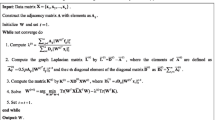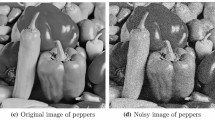Abstract
This paper develops locality preserving difference component analysis in which the intrinsic and global structure of data is exploited, and the model we propose also provides the flexibility to adapt some characteristics of data by applying the Lq norm. In order to solve the proposed model that is non-convex or non-smooth, we resort to the proximal alternating linearized optimization approach where each subproblem has good optimization properties. It is observed that the objective function in the proposed model is a semi-algebraic function. This allows us to give the convergence analysis of algorithms in terms of the Kurdyka–Lojasiewicz property. To be specific, the sequence of iterations generated by the proposed approach converges to a critical point of the objective function. The experiments on several data sets have been conducted to demonstrate the effectiveness of the proposed approach.






Similar content being viewed by others
References
Belhumeur PN, Hespanha JP, Kriegman DJ (1997) Eigenfaces vs. Fisherfaces: recognition using class specific linear projection. IEEE Trans Pattern Anal Mach Intell 19:711–720
Baccini A, Besse P, Falguerolles AD (1996) A L1-norm PCA and A heuristic approach. Ordinal Symbol Data Anal 1:359-368
Ding C, Zhou D, He X, Zha H (2006) R1-PCA: rotational invariant L1-norm principal component analysis for robust subspace factorization. In: Proceedings of 23rd international conference on machine learning
Yang J, Zhang D, Frangi A, Yang Y (2004) Two-dimensional PCA: a new approach to appearance-based face representation and recognition. IEEE Trans PAMI 26(1):131–137
Ye J (2005) Generalized Low rank approximations of matrices. Mach Learn 61(1–3):167–191
De la Torre Fernando, Michael B (2001) Robust principal component analysis for computer vision. In: Proceedings of ICCV, pp. 362-369
Liang Z, Li Y (2010) A regularization framework for robust dimensionality reduction with applications to image reconstruction and feature extraction. Pattern Recognit 43(4):1269–1281
Meng D, Zhao Q, Xu Z (2012) Improve robustness of sparse PCA by L1 norm maximization. Pattern Recognit 45(1):487–497
Ke Q, Kanade T (2005) Robust L1 norm factorization in the presence of outliers and missing data by alternative convex programming. In: Proceedings of IEEE conference on computer vision and pattern recognition
Kwak N (2009) Principal component analysis based on L1-norm maximization. IEEE Trans Pattern Anal Mach Intell 30(9):1672–1680
Nie F, Huang H, Ding C, Luo D, Wang H (2011) Robust principal component analysis with non-greedy L1-Norm maximization. In: Proceedings of 22\({nd}\) international conference on artificial intelligence, pp. 1433–1438
Wang R, Nie F, Yang X, Gao F, Yao M (2015) Robust 2DPCA with non-greedy L1-nom maximization for image analysis. IEEE Trans Cybern 45(5):1108–1122
Li X, Pang Y, Yuan Y (2009) L1-norm based 2DPCA. IEEE Trans Syst Man Cybern Part B 40(9):1170–1175
Pang Y, Li X, Yuan Y (2010) Robust tensor analysis with L1 norm. IEEE Trans Circuits Syst Video Technol 20(2):172–178
Zhong F, Zhang J (2013) Linear discriminant analysis based on L1 norm maximization. IEEE Trans Image Process 22(8):3018–3027
Wang H, Lu X, Hu Z, Zheng W (2014) Fisher discriminant analysis with L1 norm. IEEE Trans Cybern 44(6):828–842
Zhong F, Zhang J, Li D (2014) Discriminant locality preserving projections based on L1 norm maximization. IEEE Trans Neural Netw Learn Syst 25(11):2065–2074
Li Z, Tang J, Mei T (2019) Deep collaborative embedding for social image understanding. IEEE Trans PAMI (in press)
Kwak N (2015) Principal component analysis based on Lp-norm maximization. IEEE Trans Cybern 44(5):594–609
Liang Z, Xia S, Zhou Y, Zhang L, Li Y (2013) Feature extraction based on Lp norm generalized principal component analysis. Pattern Recognit Lett 34(9):1037–1045
Oh J, Kwak N (2013) Generalization of linear discriminant analysis using Lp norm. Pattern Recognit Lett 34(6):679–685
Li Z, Tang J (2015) Unsupervised feature selection via nonnegative spectral analysis and redundancy control. IEEE Trans Image Process 24(12):5345–5355
Li Z, Tang J, He X (2018) Robust structured nonnegative matrix factorization for image representation. IEEE Trans Neural Netw Learn Syst 29(5):1947–1960
Li Z, Liu J, Tang J, Hu H (2015) Robust structured subspace learning for data representation. IEEE Trans PAMI 37(10):2085–2098
Zhao H, Wang Z, Nei F (2019) A new formulation of linear discriminant analysis for robust dimensionality reduction. In: IEEE Transactions on Knowledge and data engineering
Liang Z, Xia S, Zhou Y (2013) Normalized discriminant analysis for dimensionality reduction. Neurocomputing 111:153–159
He X, Yan S, Hu Y, Niyogi P, Zhang HJ (2005) Face recognition using Laplacianfaces. IEEE Trans Pattern Anal Mach Intell 27(3):38–340
Attouch H, Bolte J, Redont P, Soubeyran A (2010) Proximal alternating minimization and projection methods for nonconvex problems: an approach based on the Kurdyka–Lojasiewicz inequality. Math Oper Res 35(2):438–457
Bolte J, Sabach S, Teboulle M (2013) Proximal alternating linearized minimization and projection methods for nonconvex and nonsmooth problems. Math Program 146:1–36
Boyd S, Vandenberghe L (2004) Convex optimization, Cambridge. Cambridge Univ. Press, Cambridge
Frank M, Wolfe P (1956) An algorithm for quadratic programming. Naval Res Logist Q 3:95–110
Garber D, Hazan E (2015) Faster rates for the Frank–Wolfe method over strongly-convex sets. In: ICML, pp. 541–549
Jaggi M (2013) Revisiting Frank–Wolfe: projection-free sparse convex optimization. ICML 28(1):427–435
Nanculef R, Frandi E, Sartori C, Allende H (2014) A novel Frank–Wolfe algorithm. analysis and applications to large-scale SVM training. Inf Sci 285:66–99
Bubeck S (2015) Convex optimization: algorithms and complexity. Found Trends Mach Learn 8(3–4):231–358
Yang WH (1991) On generalized holder Inequality. Nonlinear Anal Theory Appl 16(5):489–498
Liu J, Ye J (2010) Efficient L1/Lq Norm Regularization, arXiv:1009.4766v1
Sra S (2011) Fast projections onto L1,q-norm balls for grouped feature selection. In: European conference MLKD in databases
Manton JH (2002) Optimization algorithms exploiting unitary constraints. IEEE Trans Signal Process 50(3):635–650
Golub G, Loan CV (1996) Matrix computations. Johns Hopkins, Baltimore
Mordukhovich Boris S (2006) Variational analysis and generalized differentiation I basic theory. Springer, Berlin
Martines AM, Benavente R (1998) The AR face database. Technical report, CVC
Acknowledgements
This work is partially supported by the Fundamental Research Funds for the Central Universities (2015XKMS084).
Author information
Authors and Affiliations
Corresponding author
Additional information
Publisher's Note
Springer Nature remains neutral with regard to jurisdictional claims in published maps and institutional affiliations.
Rights and permissions
About this article
Cite this article
Liang, Z., Chen, X., Zhang, L. et al. Locality preserving difference component analysis based on the Lq norm. Pattern Anal Applic 23, 735–749 (2020). https://doi.org/10.1007/s10044-019-00834-y
Received:
Accepted:
Published:
Issue Date:
DOI: https://doi.org/10.1007/s10044-019-00834-y




